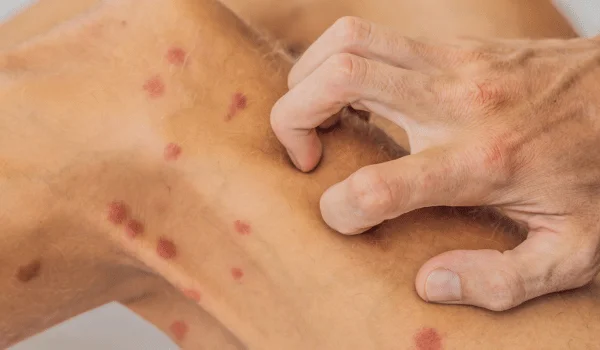You’re going about your day when you notice them — tiny red dots on your arm. They don’t itch. They don’t hurt. They’re easy to ignore.
But what if I told you that these small red spots could be more than just a harmless skin quirk — and might actually be a warning sign from your body ?
While some red spots are completely benign, others can signal underlying health issues — from liver problems to blood disorders , vitamin deficiencies , or even autoimmune conditions .
Let’s explore the most common causes of small red spots on the skin — and when you should stop ignoring them .
What Are These Small Red Spots?
The tiny red spots you might see on your arms, legs, or torso are often called:
Petechiae – Pinpoint red, purple, or brown spots caused by broken capillaries
Cherry angiomas – Bright red, dome-shaped bumps caused by clustered blood vessels
Purpura – Larger purple or red patches from bleeding under the skin
While cherry angiomas are usually harmless and age-related, petechiae and purpura can be signs of something more serious — especially if they multiply quickly or appear without injury .
6 Possible Causes of Small Red Spots on the Skin
1. Petechiae – A Sign of Blood or Platelet Issues
Petechiae are tiny red or purple dots that don’t blanch (fade) when pressed. They occur when tiny blood vessels (capillaries) break under the skin.
Possible causes:
- Low platelet count (thrombocytopenia )
- Infections (like strep, sepsis, or viral infections )
- Autoimmune disorders (like lupus or ITP )
- Medications (anticoagulants, antibiotics, or chemotherapy)
When to worry : If petechiae appear suddenly, spread quickly, or are accompanied by fever, fatigue, or bruising , see a doctor immediately.
2. Cherry Angiomas – Usually Harmless, But Monitor Changes
These are small, bright red bumps that often appear after age 30. They’re made of clusters of blood vessels and are very common .
- Generally not dangerous
- Can increase with age
- May grow or multiply over time
When to see a doctor : If they bleed, change shape, or become painful , get them checked to rule out skin cancer.
3. Liver Disease – A Hidden Warning Sign
The liver plays a key role in blood clotting. When it’s not functioning properly, blood vessels become fragile .
One early sign? Spider angiomas — red spots with radiating lines that look like spider legs — and palmar erythema (red palms).
Other symptoms:
- Yellowing of the skin (jaundice)
- Swelling in the legs or abdomen
Fatigue and nausea
If you have liver risk factors (alcohol use, hepatitis, fatty liver), don’t ignore skin changes.
4. Vitamin Deficiencies
Deficiencies in vitamin C (scurvy) or vitamin K can weaken blood vessels and lead to easy bruising and petechiae .
- Vitamin C deficiency – Rare today, but possible in poor diets
- Vitamin K deficiency – More common in people with digestive disorders or on blood thinners
5. Physical Strain or Trauma
Sometimes, red spots are caused by:
- Forceful coughing or vomiting
- Heavy lifting
- Tight clothing or pressure
These usually go away on their own and are not dangerous — but if they don’t fade, get checked.
6. Autoimmune or Inflammatory Conditions
Diseases like:
- Lupus
- Rheumatoid arthritis
- Vasculitis (inflammation of blood vessels)
…can cause rashes, petechiae, or purpura as part of their symptom profile.
When to See a Doctor
Don’t panic — but do act if you notice:
- Red spots that don’t fade when pressed
- Spots that spread rapidly
- Unexplained bruising alongside the spots
- Fever, fatigue, or joint pain
- A history of liver disease, blood disorders, or autoimmune illness
A simple blood test or dermatology visit can help determine the cause.
How Doctors Diagnose the Cause
Your doctor may:
- Perform a physical exam of the spots
- Order a complete blood count (CBC) to check platelets
- Test liver function or vitamin levels
- Examine for signs of infection or autoimmune disease
- In most cases, the cause is treatable — but early detection is key.
Frequently Asked Questions
Are small red spots on the arm dangerous?
Some are harmless (like cherry angiomas), but others — like petechiae — can signal serious conditions and should be evaluated.
Can stress cause red spots on the skin?
Stress doesn’t directly cause them, but it can weaken the immune system or trigger autoimmune flares that lead to skin changes.
Do red spots go away on their own?
Benign spots like cherry angiomas stay but don’t spread. Petechiae may fade if the cause is temporary — but if they persist, see a doctor.
Can high blood pressure cause red spots?
Not directly, but severe hypertension can damage blood vessels and contribute to petechiae or purpura .
Final Thoughts
That small red spot on your arm might seem like nothing — but your skin is often the first place your body shows signs of internal imbalance .
Don’t brush it off. Don’t assume it’s just aging or dry skin.
Take a closer look. Take a photo. Track changes.
Because sometimes, the smallest red flag is the one that leads to the biggest health discovery
